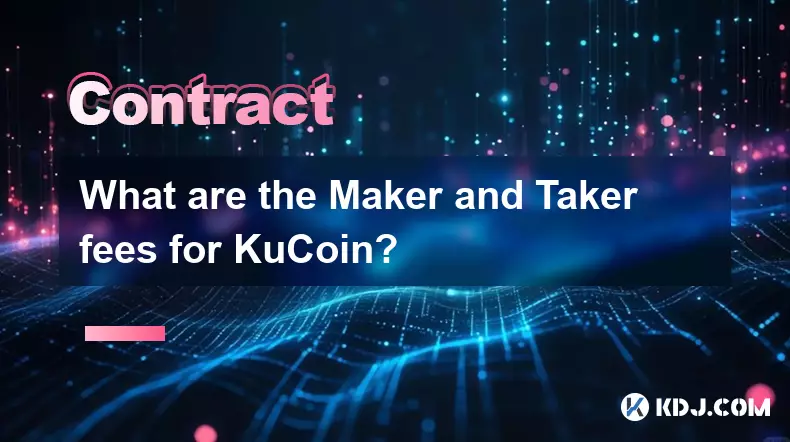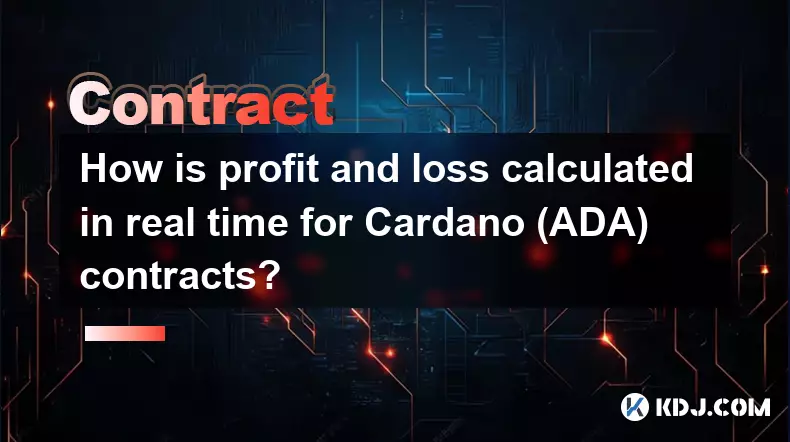-
 bitcoin
bitcoin $109667.069529 USD
-3.03% -
 ethereum
ethereum $3936.685804 USD
-4.07% -
 tether
tether $1.000493 USD
0.01% -
 xrp
xrp $2.771823 USD
-4.74% -
 bnb
bnb $957.805027 USD
-5.34% -
 solana
solana $196.735100 USD
-6.68% -
 usd-coin
usd-coin $0.999727 USD
-0.01% -
 dogecoin
dogecoin $0.227355 USD
-5.12% -
 tron
tron $0.335205 USD
-0.81% -
 cardano
cardano $0.779256 USD
-3.59% -
 ethena-usde
ethena-usde $0.999900 USD
-0.06% -
 hyperliquid
hyperliquid $42.492095 USD
-6.61% -
 chainlink
chainlink $20.501853 USD
-4.34% -
 avalanche
avalanche $28.952606 USD
-11.21% -
 stellar
stellar $0.356038 USD
-3.93%
What are the Maker and Taker fees for KuCoin?
KuCoin offers competitive trading fees with maker and taker rates starting at 0.10%, reducible through KCS holdings, VIP tiers, and liquidity rebates.
Sep 21, 2025 at 08:54 am

Understanding KuCoin's Fee Structure
1. KuCoin operates with a dual fee model that distinguishes between makers and takers in its trading engine. Makers place limit orders that add liquidity to the order book, while takers execute market orders that remove liquidity. The platform rewards those who contribute to market depth by offering lower fees or even rebates under certain conditions.
2. Standard maker fees on KuCoin are set at 0.10%. This applies when users place limit orders that do not immediately match existing orders, thus enhancing the exchange’s available liquidity. These orders remain on the books until another trader fulfills them.
3. Taker fees are also typically 0.10% for standard accounts. This fee is charged when a trade order is executed instantly against an existing order in the order book. Because this action consumes liquidity, the fee structure reflects the cost of immediate execution.
4. Users who hold KuCoin Shares (KCS), the native utility token of the exchange, can reduce their trading fees. Holding KCS qualifies traders for tiered discounts based on the amount staked. For example, holding more than 6 KCS in one’s account reduces both maker and taker fees by 20%, while higher holdings lead to greater reductions.
5. KuCoin offers a rebate program for high-volume makers. Eligible users who consistently provide liquidity may receive a portion of their fees back, sometimes resulting in negative effective fees—meaning they get paid to trade. This incentive encourages continuous participation in building robust trading pairs.
KuCoin VIP Tiers and Fee Discounts
1. KuCoin classifies users into VIP levels based on 30-day trading volume and average KCS balance. These tiers range from VIP 0 to VIP 4, each offering progressively lower trading fees and additional benefits such as increased withdrawal limits and dedicated support.
2. At VIP 1, maker fees drop to 0.08% and taker fees fall to 0.08%, provided the user meets minimum volume and KCS requirements. Higher tiers offer further reductions, with VIP 4 achieving maker fees as low as 0.02% and taker fees of 0.05%.
3. The system recalculates VIP status daily, allowing active traders to move up or down tiers depending on recent activity. This dynamic adjustment ensures that fee structures align closely with current engagement levels rather than historical performance alone.
4. Institutional traders and market makers can apply for customized fee schedules outside the public VIP framework. These arrangements often include deeper rebates and personalized service, catering to entities that bring substantial liquidity to specific trading pairs.
5. Fee discounts from KCS holdings stack with VIP tier reductions, enabling top-tier users to achieve some of the lowest effective rates in the industry. Strategic use of KCS staking combined with high-volume trading amplifies savings significantly over time.
Fee Calculation Examples and Practical Impact
1. A retail trader placing a $10,000 limit buy order for BTC/USDT at standard rates incurs a maker fee of $10. If the same trader uses a market order, the taker fee remains $10 under default settings. The symmetry in base fees simplifies initial learning curves for new users.
2. A user holding 50 KCS and classified as VIP 2 sees their effective maker fee reduced to 0.06%. On the same $10,000 trade, the cost drops to $6—a 40% reduction compared to non-KCS holders without VIP status.
3. High-frequency traders benefiting from maker rebates might pay a negative fee of -0.01%, effectively earning $1 for every $10,000 in maker volume. This transforms their operational costs and supports scalable algorithmic strategies.
4. Fees are deducted in the quote currency by default, though users can opt to pay in KCS for additional discounts. Choosing KCS payment at full rate provides a 20% discount, compounding the advantages for token holders.
5. Withdrawal fees remain separate from trading fees and vary by blockchain network. However, frequent traders earn fee credits through promotions and loyalty programs, which can offset withdrawal costs over time.
Frequently Asked Questions
How does KuCoin define a maker versus a taker?A maker places a limit order that adds liquidity to the order book and waits to be matched. A taker places an order that executes immediately against an existing order, removing liquidity from the market.
Can I reduce my fees without holding KCS?Yes, increasing your trading volume can elevate your VIP level, which lowers fees independently of KCS holdings. However, combining both methods yields the greatest savings.
Are futures trading fees different from spot fees?Yes, futures trading on KuCoin follows a separate fee schedule. Maker fees for futures can be as low as 0.02%, while taker fees start at 0.05%, varying by contract type and user tier.
Do fees vary across trading pairs?Most major pairs follow the standard fee structure, but some newly listed or low-volume tokens may have promotional fee periods or adjusted rates to encourage trading activity.
Disclaimer:info@kdj.com
The information provided is not trading advice. kdj.com does not assume any responsibility for any investments made based on the information provided in this article. Cryptocurrencies are highly volatile and it is highly recommended that you invest with caution after thorough research!
If you believe that the content used on this website infringes your copyright, please contact us immediately (info@kdj.com) and we will delete it promptly.
- Serie A Fantasy Football: Round 25 - Your Winning Picks!
- 2025-09-26 22:25:13
- Ethereum Liquidations & MAGAX Presale: Navigating Crypto's Choppy Waters
- 2025-09-26 22:25:13
- BlockchainFX: Why Whales Are Diving into This Crypto Presale
- 2025-09-26 22:30:01
- BNB, Hyperliquid, BlockchainFX: Navigating the Crypto Landscape in 2025
- 2025-09-26 22:30:01
- MIRA Price Surges Amid Binance Campaign and Mainnet Launch: What's the Buzz?
- 2025-09-26 22:30:01
- Cipher Mining, Convertible Notes, and Prices: Decoding the Crypto Landscape
- 2025-09-26 22:30:15
Related knowledge

How do I enable the "scalping-only" mode for Cardano (ADA) contracts?
Sep 24,2025 at 03:19am
Understanding Scalping Strategies in Crypto Derivatives1. Scalping in cryptocurrency trading refers to executing multiple short-term trades within min...

What is the maximum position limit for Cardano (ADA) contracts?
Sep 23,2025 at 11:00pm
Understanding ADA Futures and Derivatives Market Structure1. Cardano (ADA) futures contracts are offered by several major cryptocurrency derivatives e...

What is the maker fee for Cardano (ADA) contracts?
Sep 26,2025 at 09:01am
Understanding Maker Fees in Cardano (ADA) Contracts1. The concept of maker fees applies broadly across decentralized exchanges and smart contract plat...

How can I view open interest in Cardano (ADA) contracts?
Sep 24,2025 at 07:36am
Understanding Open Interest in Cardano Derivatives1. Open interest refers to the total number of outstanding derivative contracts, such as futures or ...

What is the function of the insurance fund in Cardano (ADA) contracts?
Sep 24,2025 at 02:18am
Understanding the Role of Insurance Funds in Cardano Smart Contracts1. The insurance fund within Cardano's ecosystem is not a native feature directly ...

How is profit and loss calculated in real time for Cardano (ADA) contracts?
Sep 26,2025 at 04:18pm
Understanding Real-Time Profit and Loss in Cardano (ADA) Contracts1. Real-time profit and loss (P&L) calculations for Cardano-based smart contracts re...

How do I enable the "scalping-only" mode for Cardano (ADA) contracts?
Sep 24,2025 at 03:19am
Understanding Scalping Strategies in Crypto Derivatives1. Scalping in cryptocurrency trading refers to executing multiple short-term trades within min...

What is the maximum position limit for Cardano (ADA) contracts?
Sep 23,2025 at 11:00pm
Understanding ADA Futures and Derivatives Market Structure1. Cardano (ADA) futures contracts are offered by several major cryptocurrency derivatives e...

What is the maker fee for Cardano (ADA) contracts?
Sep 26,2025 at 09:01am
Understanding Maker Fees in Cardano (ADA) Contracts1. The concept of maker fees applies broadly across decentralized exchanges and smart contract plat...

How can I view open interest in Cardano (ADA) contracts?
Sep 24,2025 at 07:36am
Understanding Open Interest in Cardano Derivatives1. Open interest refers to the total number of outstanding derivative contracts, such as futures or ...

What is the function of the insurance fund in Cardano (ADA) contracts?
Sep 24,2025 at 02:18am
Understanding the Role of Insurance Funds in Cardano Smart Contracts1. The insurance fund within Cardano's ecosystem is not a native feature directly ...

How is profit and loss calculated in real time for Cardano (ADA) contracts?
Sep 26,2025 at 04:18pm
Understanding Real-Time Profit and Loss in Cardano (ADA) Contracts1. Real-time profit and loss (P&L) calculations for Cardano-based smart contracts re...
See all articles










































































